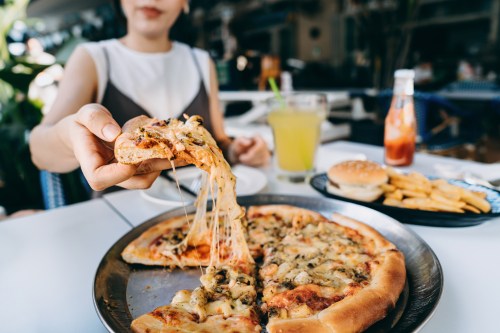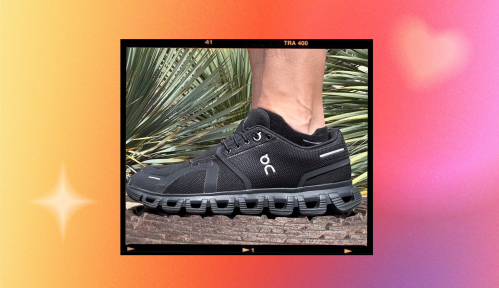Certain foods that can damage teeth (we’re looking at you, sugar!) and stain tooth enamel (hello, tomatoes!), but others can actually help prevent discoloration, fight gum disease, prevent cavities (and tooth infections), and aid with general dental health. Fruits and vegetables, in particular, are very teeth- and gum-friendly.
Experts in This Article
“A healthy diet containing fruit and crunchy vegetables will help remove plaque from your teeth,” says Marc Lowenberg, DDS, of Lowenberg, Lituchy, and Kantor. “Also, a low-sugar diet will reduce the amount of plaque that sticks to your teeth, which causes decay and gum disease.”
Ready to step up your oral health? Keep scrolling for 14 healthy foods for gums and teeth.
1. Crunchy vegetables
“I suggest stocking up on crunchy vegetables. This is because the ruffage will remove some plaque, which is a bacterial substance that sticks to the surface of your teeth,” says Dr. Lowenberg. Just one more reason to love crunchy carrots, broccoli, bell peppers, and juicy jicama.
2. Dairy products
“Milk, yogurt, cheese, and other dairy products are great for strengthening tooth enamel and fighting against cavities, as they are high in calcium and protein,” explains Jeffrey Sulitzer, DMD, chief clinical officer with SmileDirectClub. According to the National Institutes of Health (NIH), almost all calcium in the body is stored in bones and teeth, where it supports their structure and hardness. Calcium deficiency has been shown to increase risk of teeth loss. For vegan sources of calcium that will help maintain the strength of your teeth, see here.
3. Nuts
“You want to look for nuts free of additives, specifically sugar, and ones that are high in fiber and calcium, such as almonds, which can help strengthen tooth enamel,” says Dr. Sulitzer. According to the American Dental Association (ADA), nuts are also great foods for teeth because they’re low in carbohydrates, which activates acid-producing bacteria that can lead to tooth decay. Another benefit is that chewing on nuts helps stimulate the production of saliva, which can also reduce your risk for tooth decay.
4. Leafy vegetables
“Leafy vegetables, like romaine lettuce and spinach, that contain folate can strengthen enamel, guard against gum disease, and reduce gum inflammation,” Dr. Sulitzer says. Other folate-rich foods include edamame, lentils, asparagus, and black beans.
5. Onions and garlic
“Many people don’t know that not only will these aromatic superfoods make your dishes tastier, but they are also beneficial for the teeth,” says Catrise Austin, DDS, a dental expert with Listerine. She goes on to explain that onions and garlic both have properties that can lower the bacteria that causes gum inflammation, tooth decay, cavities, and bad breath. (Yes, garlic may actually help prevent bad breath… at least long-term).
6. Shiitake mushrooms
“Shiitake mushrooms contain a polysaccharide—a type of carbohydrate—called lentinan, which regulates the immune system and breaks down plaque and bacteria in your mouth for healthier gums and teeth,” says Dr. Austin. “Try adding shiitake mushrooms to your omelettes, soups, or mixed vegetable sautés to reap the oral health benefits.”
7. Salmon
“Salmon is rich in omega-3 fatty acids, which can help make your mouth more resistant to advanced gum infections and can surprisingly help your gums heal more quickly during gum disease treatments,” Dr. Austin explains. “Other fish rich in omega-3s are mackerel, tuna, cod, sardines, and herring.”
8. Strawberries
“Believe it or not, strawberries can remove stains from your teeth,” says Austin. “Strawberries have an acid called malik acid in them that has unique whitening properties.” Same goes for apples, a food naturally good at helping keep your teeth clean.”
9. Apples
Speaking of apples, they also make the list of best foods that are good for teeth. “An apple a day keeps decay at bay,” says dentist Sharon Huang, DDS, of Les Belles NYC, a female-founded and led dentistry practice in Manhattan. Here’s why: “Fibrous foods like apples and pears are good for heart and gum health because you have to spend a little more time chewing to eat these fruits properly, [so] you’re stimulating the gums and increasing saliva production, which helps neutralize acidity in the mouth and reduces your risk of cavities.”
10. Cinnamon
Cinnamon is not just great for making cinnamon rolls. Dr. Huang says it’s also great for killing oral bacteria. You can even make your own rinse with it and make it part of your daily oral health routine to help prevent plaque and bacteria build up. To do so, Dr. Huang instructs boiling water and mixing in some cinnamon. Once the mixture cools down, swish it in your mouth for a few minutes like you would a regular mouthwash, then spit it out.
11. Sugarless gum
Okay, gum is not technically food, but Dr. Huang says the sugarless variety can help prevent bacteria growth in the mouth. “Most sugarless gums contain xylitol, a form of sugar alcohol, which has been shown to effectively prevent cavities in adults and to pass that protection to developing babies in utero,” she says. A recent study even linked chewing xylitol gum to a reduction of preterm births in pregnant women because of its ability to reduce inflammation.”
12. Mint
There’s nothing quite like the minty, so-fresh-and-so-clean feeling you get after a dentist appointment. To achieve that minty feeling long after your dentist visit, consider adding more mint to your oral health routine. “Try chewing a fresh mint leaf for a boost of fresh breath and get the benefit from its antibacterial properties,” Dr. Huang says. “Just spit out the leaf after a minute or so.”
13. Lean proteins
Adding lean proteins into your diet is another way to keep your teeth and gum health in tip top shape. “Protein and phosphorus found in lean proteins like chicken and turkey can help keep teeth healthy and strong,” Dr. Huang says. Other phosphorus-rich foods such as fish and eggs will also do the trick.
14. Whole grain foods
Whole grain foods—think oats, barley, and brown rice—are also great for oral health. Dr. Huang notes, “whole grains have B vitamins and iron which help keep gums healthy, while the magnesium keeps your teeth strong.”
Foods and products to avoid
The biggest culprit when it comes to damaging teeth, according to Dr. Lowenberg, is eating foods that stick to the surface. “If your diet is made out of primarily pasta and bread, which turn into sugars, it can contribute to poor oral health,” he says. Dr. Huang seconds this advice adding that “starches can get stuck in the mouth and in between teeth, increasing your risk for plaque and cavities.”
Sugary foods, in general, are also not the best for oral health. “Candy, especially sticky sweets, disturb the pH of the mouth and increase your risk of cavities,” Dr. Huang says. “Sodas and sports beverages should also be avoided. These liquid sugars settle onto the teeth leading to cavities, gum disease, and other oral health problems.” If you do indulge in a sweet treat (because, you know, you’re human), Dr. Huang simply advises rinsing and brushing immediately after so the sugar doesn’t get caught in a cavity-making trap.
Furthermore, “people that drink a lot of liquor tend to have a drier mouth, too,” says Dr. Lowenberg. “Also, using mouthwash with a high alcohol content can cause bad breath, so make sure to always rinse your mouth with water after.”
Implement dental hygiene best practices
A balanced diet of healthy foods will certainly contribute to a healthier mouth and less inflammation overall, but nothing beats a diligent dental hygiene routine. According to Dr. Huang, the best oral care routine involves a four-step process. First floss (once or twice a day is ideal), then brush twice a day with an electric toothbrush (hint: natural toothpastes are a good option for your teeth and the environment). Next, remove bacteria from the tongue daily using a tongue scraper. And lastly, rinse regularly using an alcohol-free mouthwash.
Regular flossing, in particular, Dr. Huang emphasizes is essential for oral hygiene (and preventing bad-smelling floss that is often linked to bad breath). “The healthiest thing you can do for your mouth and entire body is to boost up your flossing game,” she says. “The result is reduced inflammation in the whole body and a healthier smile.”
Flossing is an essential way to help prevent gum disease and sore gums. (Though if you are dealing with an achy mouth, the best home remedies for sore gums include swishing a warm saltwater rinse and applying turmeric paste.)
And most importantly, be sure to visit your dentist at least twice a year for a professional cleaning and inspection. “A great dentist will examine your entire health profile and explore any links between your oral health, nutrition, and overall health, as well as screen you for oral cancer,” Dr. Huang says. “They’ll make recommendations to help you treat and prevent problems.”
Sign Up for Our Daily Newsletter
Get all the latest in wellness, trends, food, fitness, beauty, and more delivered right to your inbox.
Got it, you've been added to our email list.










